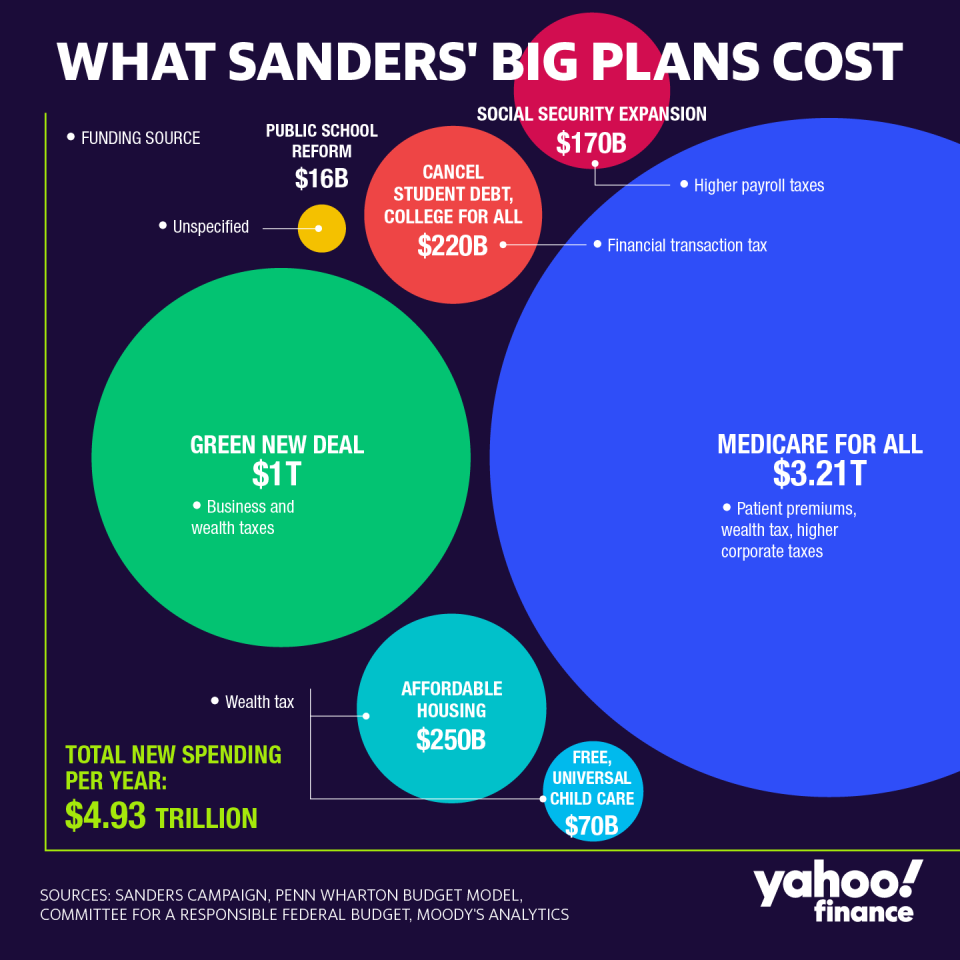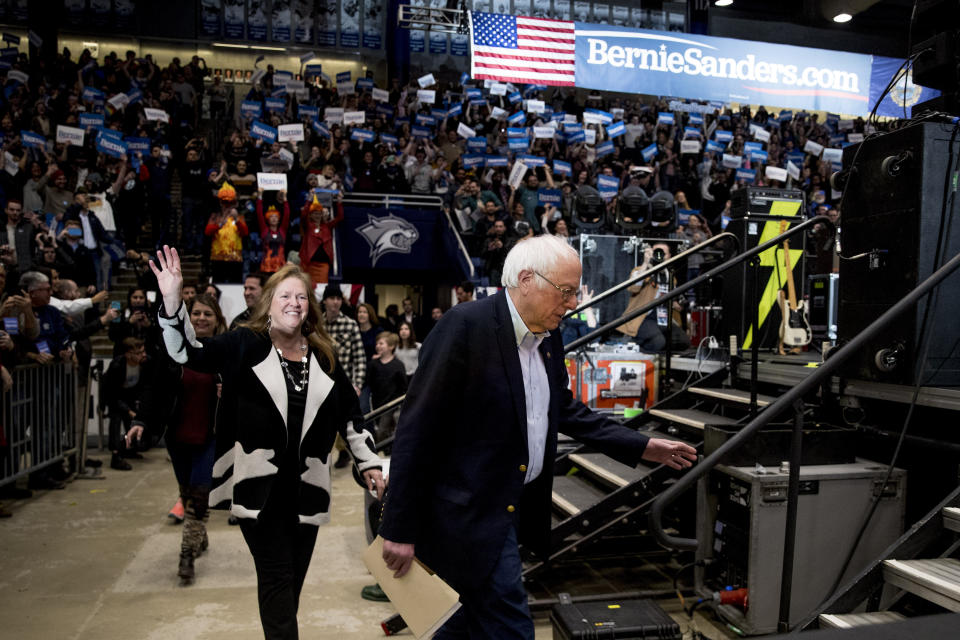The mammoth cost of Bernie Sanders’ big plans
Since he now seems to be the leading Democratic candidate for president, with victories in Iowa and New Hampshire, it’s time to give Bernie Sanders’ agenda some thorough scrutiny. Brace yourself.
Sanders proposes major changes to the U.S. economy that would remake the health care, energy, auto and financial industries. Yahoo Finance calculates the annual cost of new spending under these Sanders plans at $4.9 trillion. Washington spends around $4.5 trillion per year, so Sanders’ plans would more than double total federal spending.
Among all Democrats running for president, Sanders has the costliest agenda by a considerable margin. Yahoo Finance tallied the cost of Elizabeth Warren’s plans last fall, when she briefly looked like a frontrunner. Those plans added up to about $4.2 trillion per year, or about 14% less than Sanders. At the time, Warren backed the same Medicare for all plan Sanders has proposed, which is the biggest item on the agenda, at about $3.1 trillion per year. Warren has since backed away from Medicare for all, while Sanders hasn’t. None of the other mainstream Democrats proposes nearly much as new spending as these two.

The other giant price tag on the Sanders agenda is the Green New Deal, which would cost around $1 trillion per year. The GND would aggressively force carbon energy out of the economy by requiring a rapid transition to pollution-free automobiles and green buildings, funding research into new technologies and attempting to remove carbon from the atmosphere. Sanders would also use the GND to create 20 million unionized jobs related to the technology and equipment needed to combat global warming.
Sanders argues that many of his programs would pay for themselves and yield other dividends. “This is a fundamental question of national priorities and morals,” Warren Gunnels, a senior campaign advisor, told Yahoo Finance. “In the richest country on earth, we can guarantee health care as a human right, take on the climate crisis, end homelessness and create an economy that works for all of us. The only thing holding us back is greed.”
On paper, some of the Sanders plans look like fair tradeoffs. Independent analyses of Medicare for all, for instance, have found that a single-payer health plan run by the government could cover more people, with higher levels of coverage, for roughly the same amount the nation spends on health care today, from all sources. Instead of paying for premiums and out-of-pocket expenses, businesses and consumers would pay taxes covering the cost of the program. Because of the program’s giant scale, those taxes could end up lower than what people pay directly for health care today.
The problem is the massive disruption sure to be caused in switching from private insurers that cover about 180 million Americans to a government plan that would absorb them all. Too much government control can also depress economic growth. The Penn Wharton Budget Model recently found that Medicare for all could cause a sharp recession if implemented the wrong way, a finding the Sanders campaign disagrees with.

Understating the costs?
Backers of radical change also tend to overstate the benefits and understate the costs of their preferred policies. Backers of the 2017 Trump tax cuts said those would pay for themselves by unleashing a boom in business spending, employment and federal tax revenue. There’s no sign of that and the federal deficit is soaring, not falling, in the aftermath of the tax cuts.
Sanders has proposed a variety of tax hikes to pay for his various plans, including a wealth tax starting on fortunes of $32 million, a larger payroll tax to expand Social Security benefits, a tax on some financial trades, and a higher corporate tax. Most Americans don’t object to higher taxes on the wealthy, but Sanders’ tax hike proposals are so aggressive they’d likely meet strong resistance in Congress, even from Democrats.
Sanders’ strong showing in the early voting states is a sign that his message of a system rigged by the wealthy, for the wealthy, resonates with voters. But Sanders isn’t winning majorities yet and could still struggle to pin down the Democratic nomination. Sanders nearly won Iowa with 26% of the vote, for instance, but that also means he lost 74% of the vote. Sanders and Elizabeth Warren—the two most left-leaning Democrats—won 44% of the vote combined. But three moderates—Pete Buttigieg, Joe Biden and Amy Klobuchar—won a majority, with 54%.
Still, Sanders has the best odds of winning the nomination at the moment, even with traditional Democrats revolting against his candidacy. Other Democrats may have to start getting familiar with all those big plans.
Rick Newman is the author of four books, including “Rebounders: How Winners Pivot from Setback to Success.” Follow him on Twitter: @rickjnewman. Confidential tip line: rickjnewman@yahoo.com. Encrypted communication available. Click here to get Rick’s stories by email.
Read more:
Read the latest financial and business news from Yahoo Finance
Follow Yahoo Finance on Twitter, Facebook, Instagram, Flipboard, SmartNews, LinkedIn, YouTube, and reddit.

